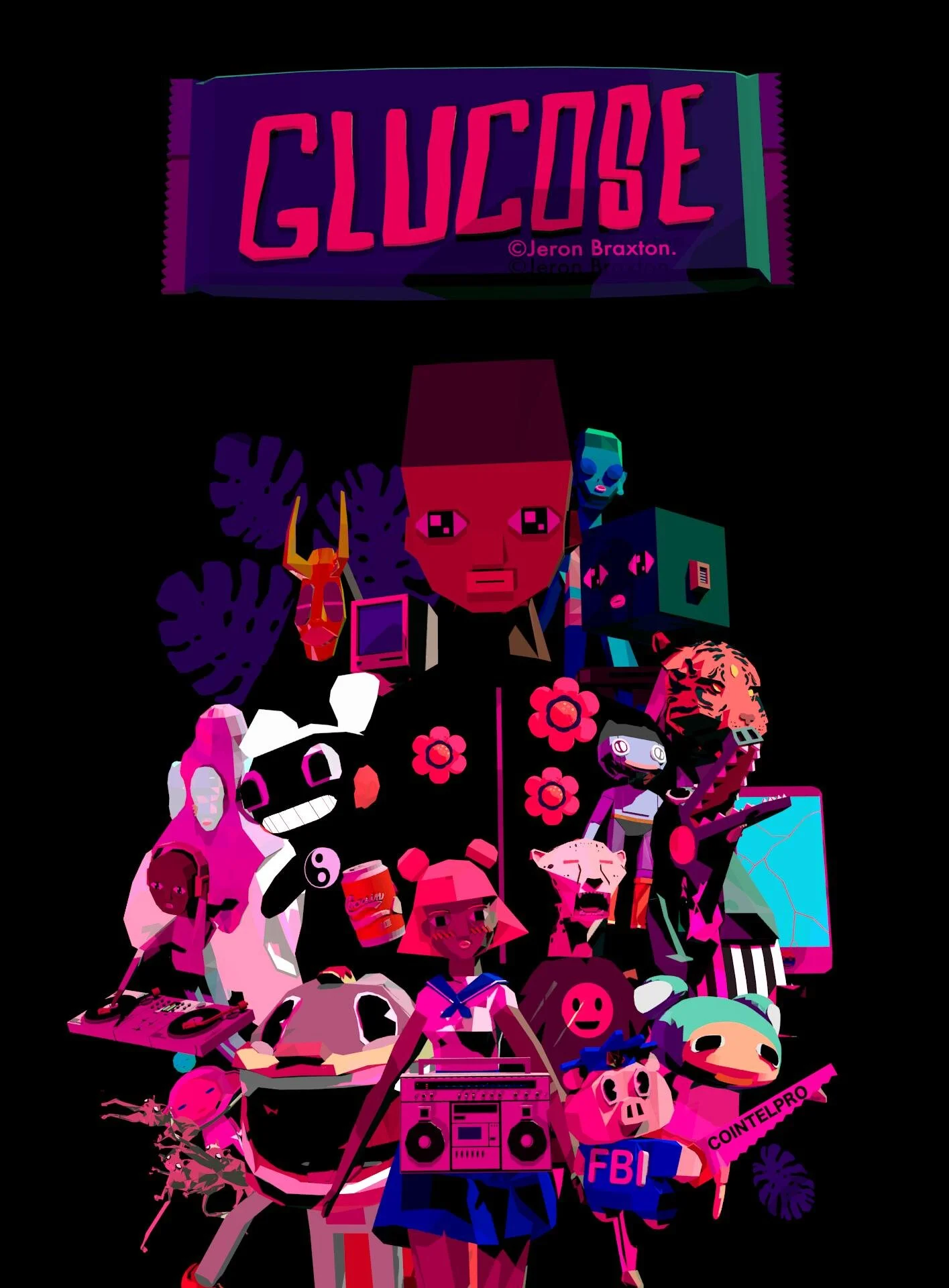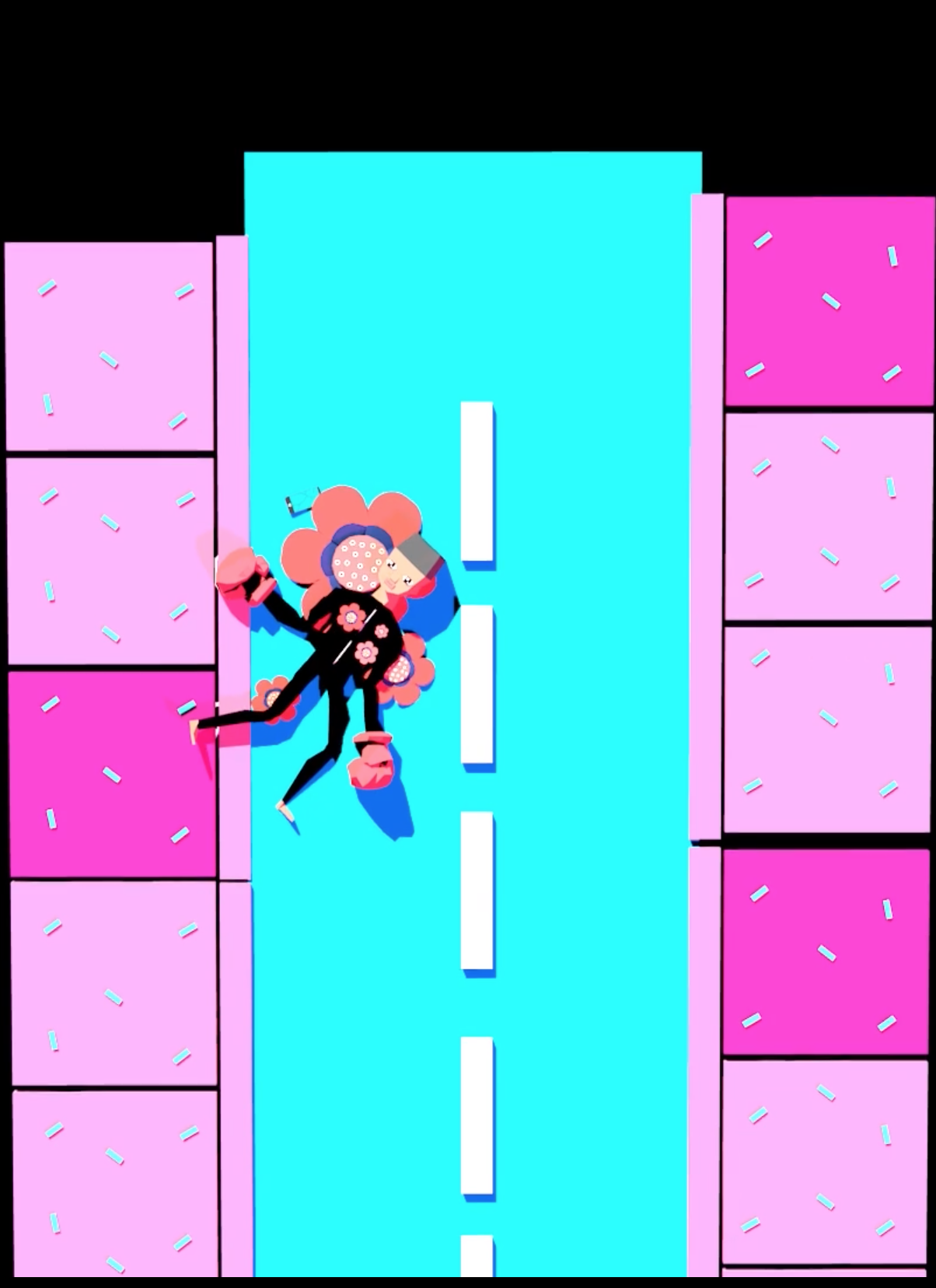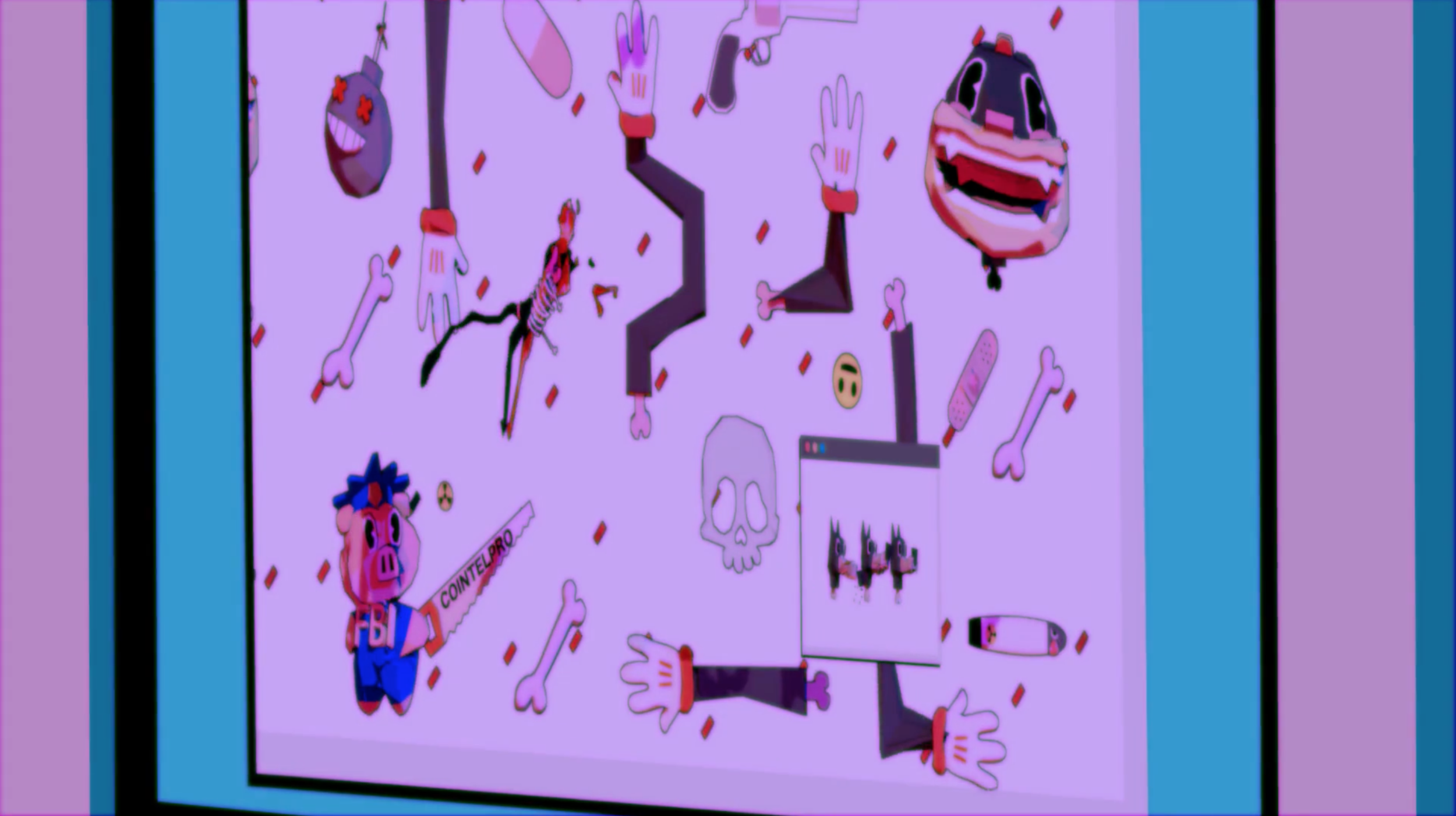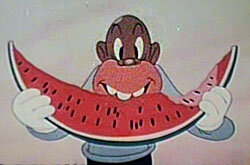Glucose
Jeron Braxton is a self-taught artist and award-winning filmmaker born in 1995 and based in New York City. His 2017 3D-animated short film Glucose won the Short Film Jury Award for Animation at the 2018 Sundance Film Festival, pushing Braxton to prominence. Described by Braxton as
“A journey through the dream of a video game character who has been [knocked out] during a match,”
Image courtesy of https://mbf.blogs.com/.a/6a00d83451ba1e69e2022ad3c44879200b-popup
Glucose uses undulating low-poly visuals and abundant pop culture references to create an experience that is simultaneously disorienting and enlightening.
Running at thirteen minutes and twenty-two seconds, Glucose portrays the winding and allegorical story of a video game boxer. Unable to win the first round of his boxing match, he dreams of things as real as an uprising of oppressed people and his own wrongful death at the hands of a police pig and things as outrageous as giant decapitated dolphins, masked entities in synchronized dance, and his own life as a science experiment inside a laboratory tank. After this elaborate dream, the boxer is able to defeat his opponent, a white leopard, in the final round of the boxing match.
Image courtesy of https://vimeo.com/226500452
Glucose incorporates vibrant, artificial colors, illuminated by red and pink lights, as well as a synth score that ranges from smooth and ambient to sharp and rhythmic, further contributing to the chaotic yet strangely soothing tone of the work. As Tunde Vollenbroek describes in an article for Cartoon Brew,
“The imagery is presented as a cheery and colorful confection, but as the film progresses, the line between dream and nightmare begin to blur.”
This tension in tone between chaos and comfort is pushed further by the fast-paced, quickly shifting messaging in contrast with nostalgic references to classic video games and cartoons, including the “versus” screen of a melee game such as Tekken, Super Mario’s Super Stars and Super Mushrooms, and humanoid wolves wearing Mickey Mouse gloves, reminiscent in design of Disney’s Big Bad Wolf character.
Braxton’s work is also highly political on a local and national level. For example, at one point, a twenty-dollar bill is shown, but instead of portraying a founding father, it depicts a black slave with red lash marks on his back. The reverse side is then shown, illustrating large handcuffs, as well as the statements “In Prisons We Trust” and “20 USA legal tender in part provided by IMPD’s eastside sweeps and the city council for closing IPS schools and building new jails in efforts to strengthen the school to prison pipeline.” In this context, IMPD and IPS stand for Indianapolis Metropolitan Police Department and Indianapolis Public Schools, the text and imagery on the bills comparing the mass arrests, school closures, and new jails in Indianapolis, where Braxton went to high school, to the slavery of black Americans in the 18th and 19th centuries.
Image courtesy of https://media.giphy.com/media/1DCpFBbR2TPG0/giphy.gif
However, Braxton addresses nationwide issues as well. At one point, a police pig shoots Glucose’s protagonist, the boxer, whose blood pools in the shape of flowers. A fellow pig officer then yells, “You killed the wrong guy!” and the first innocently states, “But he looked so scary :(,” a clear reference to the Black Lives Matter movement and the atrocities leading up to its inception. Glucose repeatedly comments on the sad and unjust history of black Americans throughout time, portraying Black Panthers (of the animal variety and of the Black Panther Party), black athletes and musicians, police pigs carrying saws labeled “COINTELPRO,” and for a couple of brief shots, a dismembered chimpanzee not visually unlike the racist depictions of African Americans in cartoons of the early-to-mid 20th century, such as Fantasia’s centaur scene or the 1941 short Scrub Me Mama with a Boogie Beat.
2017 was a year full of political strife and injustice, so it is not a surprise that Braxton chose to create such a political work at this time. 2017 brought the first year of Donald Trump’s presidency, the controversial choice of many athletes (specifically athletes of color) to kneel during the national anthem, and other events that may have less obviously contributed to Braxton’s dissatisfaction with the political state of the United States and led him to create Glucose. One such example is the beginning of the #MeToo movement.
However, Glucose is not Braxton’s only politically-charged work. Braxton’s 2018 short film Octane not only tackles similar subject matter but also directly lifts imagery, such as the twenty-dollar bill previously discussed, from Glucose, earning it the title of a “follow-up” and “sibling” to Glucose. Octane uses the same low-poly visual language as Glucose but this time focuses on class struggles related to wealth and success in addition to those related to race. For example, in Octane, the slave from Glucose lifts off of the bill, entering a car with another black male before disappearing completely. This new protagonist whips around a racetrack, eventually winning a cash prize and finding that the face on the dollar bill has now been replaced with that of a Native American. What follows is a Glucose-esque montage, showing Native Americans and white cowboys killing each other, black men playing basketball, and a Trump figure being shot in the head. This sequence reminds the viewer that, although the black protagonist has gained wealth and success, giving him an advantage over other marginalized people, there are still battles to be won.
Image courtesy of https://image-cdn.hypb.st/https%3A%2F%2Fhypebeast.com%2Fimage%2F2019%2F02%2Fjeron-braxton-you-can-exhibition-thierry-goldberg-gallery-0.jpg?w=960&cbr=1&q=90&fit=max
Braxton has also made a point to reference works outside of his own. In an interview with 3D for Designers, Braxton explains that the scene of the boxer’s death in Glucose is an homage to Kehinde Wiley’s 2014 painting The Death of Chatterton.
“Of course he has the flowers in the background, but the flowers in the foreground are supposed to represent gunshot wounds and I thought that was beautiful,”
Braxton states. Both The Death of Chatterton and Glucose use the deeply sad and political image of a black man shot dead and use a floral motif as a metaphor for the birth of a movement.
Image courtesy of https://d2jv9003bew7ag.cloudfront.net/uploads/The-Death-of-Chatterton-2014-by-Kehinde-Wiley.jpg
The Sundance Film Festival program describes Glucose thus:
“Sugar was the engine of the slave trade that brought millions of Africans to America. Glucose is sweet, marketable, and easy to consume, but its surface satisfaction is a thin coating on the pain of many disenfranchised people.”
This description is interesting because it not only addresses the real-life subject matter of the work but also the work itself. Glucose is a deeply meaningful, multi-faceted, and relevant work, but one may miss out on this aspect of it, instead choosing to focus on its sweet and stomachable formal elements.
Glucose is a fascinating piece of work, jam-packed with references, social meaning, and creative vision.
“I approached Glucose more as an art piece, more like a painting or a sculpture. I wanted to get a lot of conceptual ideas across and I chose animation to do that,”
Braxton explains.
“The main idea was obviously to reflect the human experience, my experience as a black man. And more than that, as a human using technology… Explicitly, I wanted it to be a reflection of the Internet. Each time we get [online] it’s a journey that doesn’t really have a narrative, but it’s all connected because it’s the same universe, or algorithm…”
Image courtesy of https://thinkinganimation.com/wp-content/uploads/2017/08/DFqpwuoVoAAw8T9.jpg
Glucose is the type of artwork that has so much content that one wants to watch it over and over again, hoping to pick up every shape, color and texture. Along the way, the viewer will likely pick up a deeper understanding of the black American experience and the dark history of the United States that continues, even today.
Sources:
https://www.sundance.org/blogs/news/2018-film-festival-awards
https://www.jeronbraxton.com/about
https://www.youtube.com/watch?v=deAN_pdfrbw
https://www.patternindy.com/qa-with-jeron-braxton/
https://cbs4indy.com/news/impd-east-side-sweep-part-of-high-visibility-enforcement-effort/
https://www.3dfordesigners.com/blog/jeron-braxton
https://www.thefader.com/2018/07/23/jeron-braxton-octane-short-film-glucose
https://www.cartoonbrew.com/cb-fest/glucose-by-jeron-braxton-152284.html
https://abcnews.go.com/International/2017-review-biggest-stories-year/story?id=51792152














